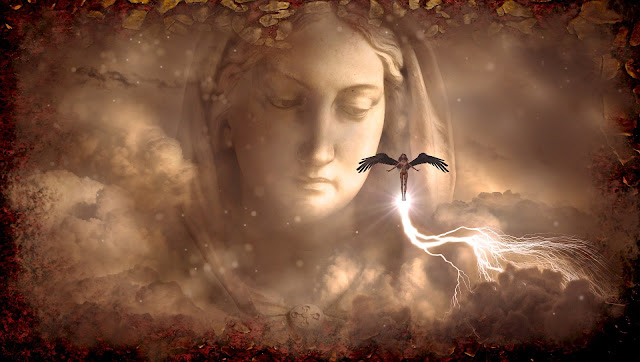The Path of the Christian Witch - Reviewed
I've seen some controversy from both sides regarding the question of whether one can be a Christian and a witch. I believe you can, but I do understand why some Christians and some neo-pagans who can't see past their own way of thinking may believe it's impossible.
Adelina St. Clair, author of The Path of the Christian Witch, shares in memoir form how she went from traditional Catholic to a Catholic witch who honors the feminine face of God. She guides the reader from her childhood with strict yet loving Catholic parents to her questioning college years where she struggled with combining her passion for her new path of witchcraft while not wanting to let go of her deeply loved Catholicism.
We get to see the struggle some feel not just in coming out to their Christian family but also to their Pagan friends when their paths don't fit neatly into either paradigm. I think anyone new to witchcraft who has come up against extremely anti-Christian Pagans will be able to relate.
Christian Witch or Wiccan?
I believe this book would be more aptly titled Path of the ChristoWiccan. Her Lord and Lady, a concept from Wicca, are Jesus and Mary Magdalene.
The author only touches on the fact that witchcraft isn't necessarily a religious practice in about two paragraphs of the entire book. In fact, she conflates Wicca with witchcraft so much that a newcomer may end up believing that all witches follow the Wiccan Rede.
This is something that I've noticed with Llewellyn's Pagan books however. They are often written from a Wiccan standpoint but aren't necessarily represented that way on the cover or in promotional material.
I don't begrudge the author or anyone else combining Wicca and Christianity. On the contrary, my personal practice is eclectic and syncretic and many Christopagans see Mary Magdalene and Mary, the mother of Jesus, as suppressed forms of the Goddess. But the author does give the impression that "this is witchcraft" throughout the book when it is only one strand of the Craft.
The Patriarchy
After being involved many years with women's spirituality groups, I recognized some of the dogma she includes in the book such as the Burning Times and some patriarchy cliches. She doesn't go so far as to say that we are all descended from peaceful goddess loving utopias, though I got the sense sometimes that she was stopping just short of doing that. But she's obviously a person who has learned to bridge the gap between two ideologies and made it work for her beautifully.
Rituals
There is a short explanation of how she chooses to celebrate Pagan and Christian holidays, namely how she blends elements of each. This isn't really a how-to book but as I mentioned a memoir of one person's path and how she reconciled contradictions. When I first read this section, I thought I could do without the intro to Pagan holidays but realized that was me not seeing through the eyes of someone new to this information. This section is short but I think would be helpful for someone who wants help in crafting their own path.
I think this might be a good read for those completely new to this concept even if their Christopagan or Christian witch path is different than hers. I can also see how many Christians and Pagans who feel caught in the middle would benefit from reading how someone else has dealt with it.
For online purchase information, visit Amazon or Llewellyn.
FTC Disclosure: The publisher has not paid me for this review and I checked this book out of my local library.
© Trish Deneen
Adelina St. Clair, author of The Path of the Christian Witch, shares in memoir form how she went from traditional Catholic to a Catholic witch who honors the feminine face of God. She guides the reader from her childhood with strict yet loving Catholic parents to her questioning college years where she struggled with combining her passion for her new path of witchcraft while not wanting to let go of her deeply loved Catholicism.
We get to see the struggle some feel not just in coming out to their Christian family but also to their Pagan friends when their paths don't fit neatly into either paradigm. I think anyone new to witchcraft who has come up against extremely anti-Christian Pagans will be able to relate.
 |
| Christian Witchcraft - Where the mysticism of Christianity and Witchcraft meet?? Credit: kellepics, Pixabay. |
Christian Witch or Wiccan?
I believe this book would be more aptly titled Path of the ChristoWiccan. Her Lord and Lady, a concept from Wicca, are Jesus and Mary Magdalene.
The author only touches on the fact that witchcraft isn't necessarily a religious practice in about two paragraphs of the entire book. In fact, she conflates Wicca with witchcraft so much that a newcomer may end up believing that all witches follow the Wiccan Rede.
This is something that I've noticed with Llewellyn's Pagan books however. They are often written from a Wiccan standpoint but aren't necessarily represented that way on the cover or in promotional material.
I don't begrudge the author or anyone else combining Wicca and Christianity. On the contrary, my personal practice is eclectic and syncretic and many Christopagans see Mary Magdalene and Mary, the mother of Jesus, as suppressed forms of the Goddess. But the author does give the impression that "this is witchcraft" throughout the book when it is only one strand of the Craft.
The Patriarchy
After being involved many years with women's spirituality groups, I recognized some of the dogma she includes in the book such as the Burning Times and some patriarchy cliches. She doesn't go so far as to say that we are all descended from peaceful goddess loving utopias, though I got the sense sometimes that she was stopping just short of doing that. But she's obviously a person who has learned to bridge the gap between two ideologies and made it work for her beautifully.
Rituals
There is a short explanation of how she chooses to celebrate Pagan and Christian holidays, namely how she blends elements of each. This isn't really a how-to book but as I mentioned a memoir of one person's path and how she reconciled contradictions. When I first read this section, I thought I could do without the intro to Pagan holidays but realized that was me not seeing through the eyes of someone new to this information. This section is short but I think would be helpful for someone who wants help in crafting their own path.
I think this might be a good read for those completely new to this concept even if their Christopagan or Christian witch path is different than hers. I can also see how many Christians and Pagans who feel caught in the middle would benefit from reading how someone else has dealt with it.
For online purchase information, visit Amazon or Llewellyn.
FTC Disclosure: The publisher has not paid me for this review and I checked this book out of my local library.
© Trish Deneen



Comments
Post a Comment